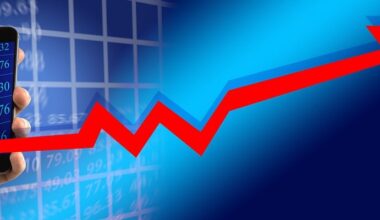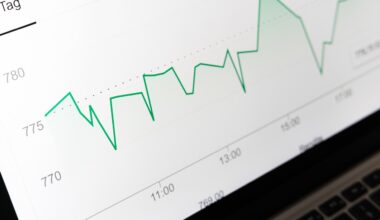Consumer Price Index vs. Producer Price Index: Key Differences
The Consumer Price Index (CPI) and the Producer Price Index (PPI) are two crucial economic indicators that provide valuable insights regarding inflation and pricing trends. They serve different purposes and measure different aspects of economic activities. The CPI tracks changes in the price levels of a basket of consumer goods and services over time. This reflects how inflation affects consumers directly. In contrast, the PPI measures the average changes in prices received by domestic producers for their output. While the CPI is more focused on consumer spending, the PPI looks at the wholesale level, where costs are initially determined. Driving the market, understanding both indexes allows economists, businesses, and policymakers to make informed decisions. Monitoring CPI helps central banks adjust monetary policies, ensuring price stability in the economy. In today’s complex economic landscape, analyzing the differences between CPI and PPI is essential for identifying potential inflationary pressures. Both indicators can vary significantly based on external factors such as supply chain issues, geopolitical events, and consumer demand. As such, tracking them can reveal deeper economic trends and conditions.
The methodology for calculating the Consumer Price Index involves a comprehensive survey of consumer spending patterns over time. This creates a fixed basket of goods and services that are representative of typical consumer expenses. The Bureau of Labor Statistics (BLS) gathers data on prices of these selected items each month. In contrast, the Producer Price Index reflects wholesale prices by encompassing a wider range of production stages and industries. This includes raw materials, intermediate goods, and finished products. The PPI also tracks prices based on several different product categories and processes. As a result, both indices use distinct methodologies that cater to their specific audiences and objectives. CPI serves primarily consumer-related insights, while PPI delivers a broader outlook impacting producers. Even subtle changes in each index can impact the economic climate and consumer confidence. Investors, businesses, and governments utilize these indicators to strategize based on anticipated inflation or deflation within the market. Understanding how both indexes function and are computed plays a critical role in the analysis of economic health, ultimately influencing decision-making processes across sectors.
Both the Consumer Price Index and the Producer Price Index can significantly impact economic policies and strategies. Policymakers examine CPI data when adjusting interest rates or implementing measures to curb inflation. A rising CPI often prompts tighter monetary policies aimed at controlling inflation. Conversely, if the PPI shows rising costs for producers without corresponding consumer price increases, it may signal future inflationary pressure. As such, PPI trends can also serve as a leading indicator, suggesting where CPI may head. Additionally, businesses use these indicators to forecast pricing strategies, manage supply chains, and negotiate contracts. Understanding how cost pressures evolve allows companies to adapt to market changes proactively. Both indexes can influence consumer behavior and spending patterns based on the perception of price changes. For example, if consumers expect rising prices, they might accelerate purchases, contributing further to inflation. Ultimately, monitoring the movement of CPI and PPI ensures that economists, businesses, and the government remain informed about the health of the economy. By synthesizing data from both indices, stakeholders can gauge inflation’s trajectory and the overall economic landscape.
Limitations of CPI and PPI
Despite their significance, the Consumer Price Index and Producer Price Index each have limitations that must be acknowledged for accurate economic interpretations. The CPI, for instance, relies on a fixed basket of goods, which may not accurately track evolving consumer preferences and societal shifts. Changes in quality of goods or the emergence of entirely new products may not be adequately represented in the index. Furthermore, CPI does not account for regional price differences, which can lead to misleading interpretations of cost of living-related trends. On the other hand, the PPI primarily reflects changes in prices paid by producers without capturing the actual prices consumers pay in the marketplace efficiently. This discrepancy can sometimes obscure the true inflationary pressures affecting consumers directly. Another limitation includes the methodology of data collection; varying collection methods may lead to inconsistencies across different regions and industries. Thus, while both indices are invaluable, they should not be viewed in isolation but rather in conjunction with other economic indicators. A comprehensive approach to understanding economic health incorporates a multitude of insights beyond CPI and PPI alone.
The relationship between Consumer Price Index and Producer Price Index is marked by causality. When producers face increased costs due to factors such as rising raw material prices, this typically reflects in the PPI. As producers pass on these costs to consumers, it subsequently affects the CPI. This indicates a lagged effect; changes in PPI can lead to future adjustments in the CPI. However, the timing and extent of this relationship can vary greatly depending on market conditions and demand elasticity. During times of robust economic growth, increased consumer demand may prompt higher PPI figures, as suppliers ramp up production to meet demand. Conversely, in a stagnant economy with low consumer confidence, rising producer costs may not immediately result in higher consumer prices, as businesses may absorb these costs to maintain sales volumes. Understanding this interplay is crucial for predicting inflation dynamics and determining the economic outlook. Analysts often assess the strength of this relationship to refine their economic forecasts and investment strategies. Therefore, both indices needs to be observed collectively, allowing for greater insight into price fluctuations across various sectors and the economy.
Impact on Investment Decisions
The fluctuations in the Consumer Price Index and the Producer Price Index can significantly influence investment decisions across various sectors. For instance, rising CPI figures might indicate increased inflation, prompting investors to seek assets that traditionally perform well during inflationary periods. Such assets may include commodities, real estate, and inflation-protected securities. On the other hand, a rising PPI, indicating increasing costs for producers, can lead investors to reassess company profitability and pricing power within certain industries. Companies unable to pass on rising costs to consumers may see their profit margins shrink. This creates a cautious approach toward investing in those segments. Understanding the implications of CPI and PPI helps investors gauge market sentiment and the economic landscape, enabling them to make informed choices. Economic cycles characterized by inflation or deflation further complicate investment strategies. Thus, monitoring CPI and PPI trends aligns investors more closely with prevailing economic conditions. This awareness can help mitigate risks associated with fluctuating prices within the market and effectively inform portfolio diversification strategies in anticipation of changing economic circumstances.
In summary, the Consumer Price Index and Producer Price Index serve as essential tools within the context of economic analysis. Both indices offer unique insights that collectively shed light on inflation, pricing dynamics, and economic health. While CPI focuses primarily on consumer price changes, PPI highlights trends at the producer level. Recognizing the key differences and interplay between these two indexes is vital for understanding inflationary pressures and devising appropriate economic strategies. Their respective methodologies, limitations, and relationships can significantly impact decision-making across multiple sectors, from businesses and government institutions to individual investors. As the economy evolves, the role of these indicators remains crucial in informing policymakers and shaping responses to economic trends. With various external factors shaping price movements, an informed understanding of CPI and PPI ensures that stakeholders maintain awareness of inflationary trends. Hence, it emphasizes the importance of tracking these indicators continuously and adjusting strategies accordingly. Ultimately, using CPI and PPI in tandem maximizes comprehensiveness, offering a more holistic view of price changes across the economy.
Conclusion
In the realm of economic indicators, comprehending the distinctions and functions of the Consumer Price Index and Producer Price Index is crucial. Both offer essential insights for assessing inflation and its effects on consumers and producers alike. While they serve different groups, their interplay significantly impacts policy decisions and investment strategies. With varied methodologies and respective interpretations, continuous monitoring of both indices allows economists and investors to navigate the complexities of today’s economic climate. As inflation remains a persistent concern, keeping an eye on these key indicators prepares stakeholders for shifts in the marketplace, driving more effective planning. Emphasizing the importance of incorporating CPI and PPI into comprehensive analyses helps pave the way for more informed decisions. In a fast-paced global economy, recognizing the signals from these indicators becomes imperative for success in both personal finance and broader economic contexts. By acknowledging their limitations while leveraging their insights, one can effectively assess economic conditions. Thus, understanding the nuances between CPI and PPI lays the foundation for stronger economic literacy and decision-making in navigating the multifaceted economic landscape.


